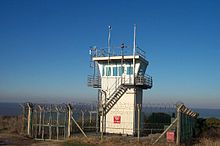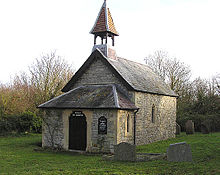| Revision as of 21:21, 1 January 2008 editWetman (talk | contribs)Autopatrolled, Extended confirmed users, Pending changes reviewers, Rollbackers92,066 edits →Coast: mentioned Early Jurassic at outset, the better to orient the reader← Previous edit | Revision as of 05:26, 8 January 2008 edit undoMahagaja (talk | contribs)Administrators92,669 edits →Church: weddings take place in churches; marriages are states in which people live after their weddingNext edit → | ||
| Line 37: | Line 37: | ||
| ] | ] | ||
| The small Church of St. Andrew, with only two rows of pews, has a chancel arch which dates from a 14th century which was demolished in 1881, when present structure erected. The Church was declared redundant 1980, and the ] front removed to Stogursey Church in 1981.<ref>{{cite web | title=Church of St. Andrew | work=Images of England | url=http://www.imagesofengland.org.uk/search/details.aspx?id=265254 | accessdate=2007-12-31}}</ref> The church was restored around 1993 but only holds one service a year. The most recent baptism in the church was in 1881 and the most recent |
The small Church of St. Andrew, with only two rows of pews, has a chancel arch which dates from a 14th century which was demolished in 1881, when present structure erected. The Church was declared redundant in 1980, and the ] front removed to Stogursey Church in 1981.<ref>{{cite web | title=Church of St. Andrew | work=Images of England | url=http://www.imagesofengland.org.uk/search/details.aspx?id=265254 | accessdate=2007-12-31}}</ref> The church was restored around 1993 but only holds one service a year. The most recent baptism in the church was in 1881 and the most recent wedding was in 1834.<ref>{{cite web |url=http://wsomparreg.mysite.orange.co.uk/ |title=West Somerset Parish Register Transcriptions |accessdate=2008-01-01 |format= |work= }}</ref> | ||
| == References == | == References == | ||
Revision as of 05:26, 8 January 2008
Human settlement in EnglandLilstock is a hamlet in the civil parish of Stringston within the West Somerset district of Somerset, England. It is 12 miles (19 km) north west of Bridgwater, and 8 miles (13 km) north east of Williton. It on the coast of Bridgwater Bay on the Bristol Channel, near the Berkeley nuclear power station.
It was recorded as Lulestock in the Domesday book, and rendered at one time as Little Stock or Little-stoke. Its name is said to have meant "the stoc of Lylla and his people".
Coast

The Blue Anchor to Lilstock Coast Site of Special Scientific Ineterest (SSSI) provides an outstanding series of sections through the Early Jurassic Lower Lias, spanning the Hettangian and Pliensbachian Stages and named the "Lilstock Formation". This sequence and the good Rhaetian succession beneath are repeatedly affected by faulting, making it of interest to geologists and fossil hunters. It also displays coastal geomorphology which demonstrates a particularly well-developed series of intertidal shore platforms varying in width from about 200-600m. The cliff and beach are rich in reptile remains, including complete skeletons. Lilstock also yields ammonites, shells and fish remains. A unique specimen of an ichthyosaur, named Excalibosaurus costini MacGowan, in which the lower jaw is shorter than the upper was found in the Lower Jurassic Sinemurian Stage, Lower Lias beds on the foreshore at Lilstock and is now in the Bristol City Museum and Art Gallery.
Harbour
Lilstock appears to have been the old port of the Saxon settlement of Stogursey.
The Acland Baronets were the lord of the manor. Around 1820 Sir John Acland built a boat house on the beach with a pier and breakwater to form Lilstock harbour. Coal was brought from Wales for domestic use on the Acland estate, and to fire the large limekiln on the cliff. Pit props were the main export along with lime. By 1848 there were resident coastguards, and by 1855 a customs officer. About 1860 a stone pier was built from the north side of the harbour wall. By 1866 warehouses were standing beneath the cliff beside the southern harbour wall. A plan for a ship canal from Seaton in Devon to terminate at Lilstock was considered by the Board of Admiralty in 1888. The harbour was apparently abandoned and the pier subsequently destroyed after the first world war.
Gunnery range

The sea off Lilstock has been used as a air gunnery practice range connected to RNAS Yeovilton. Lilstock Royal Navy Range, served as a practice bombing range for fixed-wing aircraft using inert ordinance until 1995 when it was redesignated as a helicopter gunnery range.
Church

The small Church of St. Andrew, with only two rows of pews, has a chancel arch which dates from a 14th century which was demolished in 1881, when present structure erected. The Church was declared redundant in 1980, and the Norman front removed to Stogursey Church in 1981. The church was restored around 1993 but only holds one service a year. The most recent baptism in the church was in 1881 and the most recent wedding was in 1834.
References
- "Lilstock, West Somerset". Everything Exmoor. Retrieved 2008-01-01.
- "Blue Anchor to Lilstock Coast SSSI" (PDF). English Nature. Retrieved 2007-12-31.
- "Lilstock Fossils and Fossil Collecting". UK Fossil Network. Retrieved 2007-12-31.
- "Collections - Geology - page 7 - Reptiles". Bristol City Museum. Retrieved 2007-12-31.
- "A brief history of Stogursey". Somerset County Council. Retrieved 2007-12-31.
- ^ "Lilstock harbour". Somerset Historic Environment Record. Retrieved 2007-12-31.
- "Limekiln Complex". Images of England. Retrieved 2007-12-31.
- "Lime kiln and buildings". Somerset Historic Environment Record. Retrieved 2007-12-31.
- "Kilve Bend Range". Hansard 29 Mar 2004 : Column 1142W—continued. Retrieved 2007-12-31.
- "Church of St. Andrew". Images of England. Retrieved 2007-12-31.
- "West Somerset Parish Register Transcriptions". Retrieved 2008-01-01.